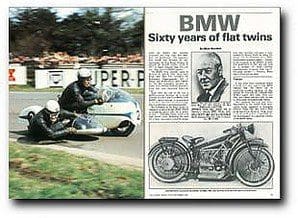
A casual glance at David Kemp’s booking form for my group trip to Coupes Moto Légende 2005 revealed he was making the trip on a BMW twin. Not that there was anything unusual in that as, over the last 80-odd years, the venerable boxer has earned an enviable reputation for its capabilities as a touring machine, and several other people riding BMWs had already signed up for the 800-mile round-trip.
What was a surprise, though, was that, unlike the others, which were predominately 1970s examples, David’s was an R12 side-valve model manufactured in 1935 and now an extremely unusual machine. David and his wife, Maggie, who was also making the trip on a 350cc Matchless ‘trials special’, are certainly no strangers to touring on a grand scale and it was as they completed one of their adventures in 1973 they acquired the R12, although it would be another 30 years before the machine would be returned to its former glory.
Along with its more sporting ohv R17 stablemate, the R12 had been launched with a fanfare of publicity at the Berlin Motor Show of 1935.
Hydraulically damped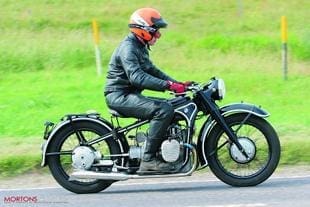
The striking feature of the two new models was the incorporation of hydraulically damped telescopic front forks that the company claimed to be a first on a production machine and a major advance over the then-common girders and their friction dampers. Other than the adoption of the telescopic forks, the pair of 750cc twins were not obviously or radically different from their R11 and R16 predecessors which, by then, had been in the company’s catalogues for six years. First shown to the public at the 1928 motorcycle show in London, they had been introduced to combat customer complaints about the R26 model, which had suffered from collapsing front forks and fractures to the frame. The fractures had been traced to the welded joints around the headstock where the tubes curved but, while the solution indicated a radical redesign of the frame, BMW opted to keep the layout of the chassis but supplant the weak tubes with pressed steel. Frames made of pressed steel were not unknown, especially in lightweight machines, but the BMW version, constructed of two riveted steel pressings welded together at the front to incorporate the steering head-stock, was of a totally new design. The forks retained the trailing link from the previous model while the main blades were also made from pressed steel.
Although the two new bikes appeared in the company’s 1929 catalogue, teething problems that necessitated a redesign of the front end held up volume production until the following spring. The 78mm x 78mm 750cc R11 side-valve engine was fitted with a single three-jet Sum carburettor with pre-heated secondary air drawn through a small tube on each side of the exhaust manifold to prevent icing.
The new models sold well and the side-valve 16bhp R11 became popular, particularly when hitched to a sidecar.
Although the next four years saw little in the way of aesthetic change, there were various improvements to the engine and gearbox, including replacement of the noisy geared timing drive to that of a chain in 1934. On the surface it would seem that, other than the adoption of the telescopic forks, the R12 was little different, but closer examination revealed a new four-speed gearbox and a conventional drum brake on the rear, which made it interchangeable with the front, while the front brake lever was now mounted inside the alloy brake plate. Despite putting on weight slightly, the R12 was undeniably eye-catching and, finished in its livery of black and bold white lining, it mirrored the avant garde art deco styling so popular at the time. It portrayed an impression of speed although, with a dry weight of 407lb, the 18bhp engine was hard-pushed to see much more than a true 100kph (60mph) on the speedo.
With war clouds gathering, production of the R12 was turned to military use and, from 1938 onwards, it was made exclusively for the German Wehrmacht.
David’s bike dates from 1935, so it is unclear if it was initially made to military spec or was later conscripted and modified, but either way its history is fascinating and I was delighted when its owner invited me to ride it.
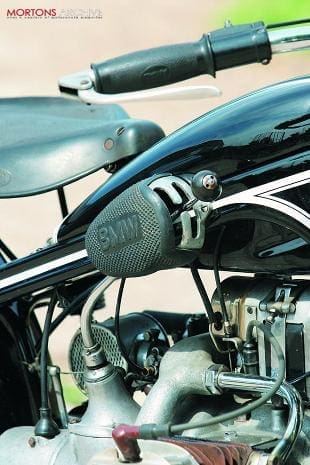 Replaced for military use
Replaced for military use
David said: “I’m given to believe that, from 1935 until 1942, BMW made around 36,000 of the R12 before it was replaced for military use by the R75. During their occupation of France in WWII, the Germans had a large repair and maintenance facility in Paris and, to keep the bikes mobile, they not only made a significant number of parts from BMW tooling, but also used many local sub-contractors. I understand from a French friend that, after liberation, this became a rather ‘delicate’ matter for the sub-contractors! With the war over, the French were understandably anxious to kick-start their industry back into action and set up the Centre de Montagne et de Réparation (CRM), which went about building, repairing and civilianising former military vehicles. About 300 R12s were refurbished and these went to the gendarmerie, army and police. The discovery of grey paint during restoration and later access to the old CRM records showed that mine is one of that 300.”
The R12 was not the first BMW that David has owned, as in 1970 he had bought a majestic R60 with £200 bequeathed to him by his grandfather, although his first venture on two wheels was with a rather more humble machine, as he told me: “I first got interested in bikes in my early teens through a friend in the New Forest who had a Sun two-stroke we used for tearing around the fields so, when I was old enough, I bought myself a 125cc James. I paid £5 for it and got it for no other reason than it had a Jim Alves Motorcycles sticker on it! It was a super little bike and amazingly always started first kick. When I went to university I took the James with me but one day someone nicked it. However, the thief didn’t get very far because, within 100 yards, the clutch cable snapped and it was abandoned!”
Later Dave progressed to a Triumph T100A although, on his own admission, at this stage he was not particularly adept with ‘things mechanical’ so, when he became bitten by the travel bug, the R60 was his obvious choice. This was the start of motorcycling adventures on a grand scale, with an eight-week trip through North Africa.
“In 1973 Maggie and I were in Kabul (Afghanistan) and we decided it would be fun to get a bike and ride back to the UK, so we found and bought a M72 side-valve Ural. This was not without its problems as, before it could be released to us, all previous 10 owners had to be gathered together before the papers could be signed over to us.
“In Iran we ended up in an irrigation ditch, which bent the forks, but we managed to struggle to the next village, where we found the local mechanic, who stripped and straightened them for us. Not only did he straighten the forks, he gave us lunch and, on departure, steadfastly refused all payment. We later had problems with the gearbox and, despite having the selector fork welded up, eventually lost top, so we limped all the way back in third.
Exchange & Mart
“We were stopped at a small town in northern France when a man came by who obviously knew quite a lot about the Ural and invited us to see his collection of unusual bikes and scooters. He was interested in getting a Welbike but hadn’t been successful and asked me if, on my return to England, I could get him one. Some time later I saw one advertised in Exchange & Mart for £50 and took it to him on the train.
“He was delighted with it but, instead of paying me, took me round the back to reveal a barn jam-packed full of rusty motorbikes and told me to select something as payment. After getting over the initial shock I had my eyes on a Sarolea 600cc single but he (Maurice Chapleur) insisted that I take the BMW which, although very rough and seized, was complete and would be a much better machine to restore.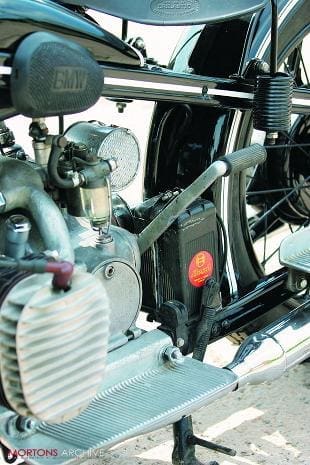
“After getting some air into the tyres, I manhandled it to the nearby railway station and took it on the train to Versailles, where I had a friend who stored it for me for a while and later brought it back to the UK.”
With other touring adventures in the 1970s, which included another trip to Afghanistan aboard an A10 outfit followed by raising a young family and running the pig farm they bought in 1984, the BMW was consigned to the back of David’s and Maggie’s shed until 2002, when it was dragged out into the daylight once again.
“I always thought ‘I’ll do that one day’ but our motorcycling was put on hold while the children were growing up so I thought that I’d better get on and restore it before I got too old!”
From the outset the strip-down was not without its problems as the right-hand cylinder was seized along with the exhaust valve and piston, which were jammed. This called for a considerable amount of ‘persuasion’ along with liberal quantities of WD40 and gentle heating before it was all freed up and dismantled. There are several specialists in mainland Europe on BMWs ‘Mobile Tradition’ list of approved dealerships, and it was one of these, Mark Huggett in Switzerland, who Dave entrusted with the crank rebuild. Mark stripped and reground the crank and, to preserve the cages, fitted oversize rollers. Back home in Wiltshire, a local engineer rebored the barrels, which were surprisingly still on the standard bore. Dave has been unable to verify the mileage but, as the speedo is still functioning, the reading of 35,000km would appear to be genuine.
“Very impressed” was the owner’s summing-up of Mark’s crank rebuild, but he wasn’t quite as complimentary about the quality of work carried out on the magdyno.
He said: “It cost me 400 quid to have the magdyno refurbished but, after I fitted it back into the bike, it would only run about 20 minutes before it would cut out, although after it had cooled down it would run OK again. Despite my protestations to the guy who did the work, I was getting nowhere with him so had to look elsewhere. I was at the autojumble in Mannheim where I met Hans Sellwen, who specialises in renovating Bosch magdynos, and he did a superb job for me. He overhauled it and fitted an electronic regulator hidden inside the dynamo, and I now have perfect sparks.
“While I was rebuilding the engine, the petrol tank and all of the tinware was resprayed by Brian Dees of Deespray in Rochester, who also did a top-quality job.”
Sourcing spares was not without its problems but, with contributions from China (tappet), Germany (silencers), Italy (pistons) and Hungary (tank rubbers), 18 months’ hard work saw the gleaming BMW completed. It was time for a proving run which, as might be expected given the owner’s track history, was not reserved to just a quick ride around the block and also not without its setbacks.
Dave explained: “The last Coupes Moto Légende at the Montlhéry autodrome was looming so I though it would be good to take the ‘Bee-Em’ and give it a good shake-down. It started well enough but, as the trip progressed, I noticed an increase in vibration and then there was a bang and I stopped. Later investigation revealed that the flywheel had fallen off, which resulted in damage to both the main shaft and flywheel.
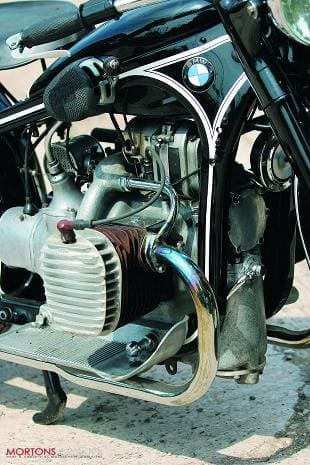 Metal-sprayed
Metal-sprayed
“The engine was stripped yet again and the damaged parts sent to John Laws in the Midlands, who metal-sprayed the crank, which was then reground locally by Graham Ames at Apsley Engineering.”
With engine suitably rebuilt and the sparks problem cured courtesy of Hans Sellwen, Dave, along with Maggie on her trusty Matchless, embarked on a trip to the Pyrenees in the autumn of 2004 and, needless to say, the BMW ran faultlessly.
It was now my turn to take it on a trip of slightly less epic proportions across the nearby Salisbury Plain.
For anyone brought up on side-mounted kick-starts, BMW’s system of a lever mounted across the back of the bike is not an easy one to perfect but, with the ignition slightly retarded and the choke plunger pulled fully on, it was a first time starter. Certainly both mechanically and exhaust note-wise the bike was extremely quiet.
As is befitting the era, the bike is equipped with inverted clutch and brake levers mounted on the end of the wide rakish bars that, along with the headlamp-mounted speedo, make for a clean and uncluttered layout to the ‘cockpit’ area. The clutch itself was feather-light in operation, although I immediately knew I was on a BMW from the characteristic ‘clonk’ the gearbox made when first was engaged. Dave had forewarned me about the stiff twist-grip that, he added with a smile, was a design feature to help the rider set the revs when changing gear. Although this was said tongue in cheek, I did find it extremely useful and soon discovered both up and down changes could be made very smoothly through the four-speed box.
I also found that the engine was surprisingly revvy and was soon bowling along at the respectable rate of knots that, at an indicated 80kph, felt very comfortable and relaxed. It was originally on sidecar gearing but Dave managed to locate a solo crown wheel and pinion at an autojumble in Germany that has made touring a more leisurely experience, although it is still a bit of a gas-guzzler and returns only the low 40s to each gallon of petrol. At 80kph the combination of damped telescopics allied to a rigid rear and sprung saddle gave the bike a slight ‘pitching’ sensation, but the 3.50 x 19in tyres gave it a reassuringly sure-footed and stable feel. The only upset to this was when we hit one of the famous Salisbury Plain tank crossing-points, which bottomed out the front forks. They responded with a resounding clang and there was slight wiggle through the handlebars.
 The wide bars and alloy footboards afforded a comfortable riding position although, being heal-operated, the rear brake was not overly easy to locate. Perhaps this was fairly academic as I was wary of the efficiency of the brakes.
The wide bars and alloy footboards afforded a comfortable riding position although, being heal-operated, the rear brake was not overly easy to locate. Perhaps this was fairly academic as I was wary of the efficiency of the brakes.
The R12 was a joy to ride and it was with great reluctance that my tour finished and I returned the bike to its proud owner. Dave’s motorcycling ethos mirrors that of my own in that bikes are made for riding and, although his trips these days may not take on the magnitude of travelling through the wilds of Afghanistan, the week following my visit saw the BMW along with Maggie on the Matchless depart for a trip to the Alps. The R12 is a credit to its owner and guaranteed to give him a lot of riding pleasure.



